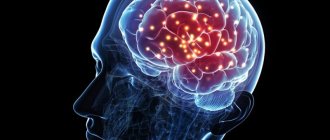Schizophrenia is a mental disorder due to internal disturbances in the body, characterized by pathological behavior, emotions, attitude towards people, inadequate perception of the world and reality.
The development of the disease is not associated with exposure to external factors and may have a paroxysmal or continuous course.
With the disease, difficulties with communication are observed in a person at various stages of life - from early childhood to old age, from the period of attending school to working in a team.
According to statistics, every 5-6 people out of 1000 are susceptible to schizophrenia. Gender does not matter, although in men the disease manifests itself at an earlier age - from 15 years, in women from 25 years. Pathology is usually found in people between 15 and 30 years old. Out of 100 people with schizophrenia, about 10 decide to commit suicide.
The pathology affects a person for the rest of his life. Moreover, many symptoms can be eliminated completely with a competent combination of traditional and traditional treatment, which can only be selected by a highly qualified psychiatrist.
With pathology, a person’s thinking and perception suffer while maintaining the normal functioning of memory and intellect. The brain of schizophrenics is able to correctly perceive information, but the organ cortex cannot process it correctly.
Causes
The exact reasons for the development of this mental illness have not been identified. Scientists have put forward a number of factors that increase the likelihood of pathology:
- Hereditary predisposition . If close relatives have the disease, schizophrenia appears in 10% of cases. When a pathology is diagnosed in one of the identical twins, the probability of the disorder occurring in the second increases to 65%. There is a version that for the development of a mental disorder one hereditary factor is not enough, a combination of several reasons is necessary.
- Childhood education . One of the assumptions for the occurrence of schizophrenia is the provision of insufficient attention by parents to their children.
- Pathologies of intrauterine development, mainly the impact of infections on the child.
- Bad habits . The use of amphetamines contributes to the worsening of signs of mental illness. The use of hallucinogenic and stimulant drugs, including smoking, can trigger the development of the disorder.
- Social factors . Scientists claim a connection between loneliness or stressful situations caused by a negative social situation with the manifestation of schizophrenia.
- Disturbances of brain chemical processes . The makings of pathology can be laid down during intrauterine development, but appear only during puberty.
Symptoms and effective treatment of scoliosis at home.
Can Dupuytren's contracture be treated without surgery? Find out in this article.
Intrauterine infections and difficult labor
The main factors that increase the risk of the disease include intrauterine infections and difficult childbirth. It has been established that people born in winter or spring most often get this disease. There is also a strong correlation between the prevalence of the disease and a number of social factors, for example, the level of urbanization (city residents suffer from schizophrenia more often than rural residents), poverty, unfavorable childhood conditions, and family moves due to difficult social conditions.
Not everyone knows how people get schizophrenia.
Symptoms of the disorder
In the first stages of pathology, symptoms may be mild and often go unnoticed. At the same time, achieving an effective result is only possible if treatment is started in the early stages of a mental disorder. Therefore, it is important not to miss this moment before the disease progresses to more severe forms.
READ ALSO: Jaundice in newborns: effective treatment at home
Manifestations can be very diverse. The main symptoms of schizophrenia are:
- negative signs - lack of emotions and pleasure from anything, withdrawal from social life and self-isolation, fading desire for self-care;
- positive manifestations - a person hears voices in his head, is delirious, feels watched from the outside;
- unexpected mood swings - from joy to depression;
- cognitive symptoms – difficulties with processing even basic information, disturbances in thinking and memory.
There are certain signs of schizophrenia that are observed in males:
- aggressiveness;
- self-isolation from society;
- the appearance of voices in the head;
- persecution mania.
Features of the manifestation of the disease in women are:
- frequent reflection;
- persecution mania;
- rave;
- hallucinations;
- conflicts against the background of social interests.
You can suspect the presence of the disease in children based on the following symptoms:
- Rave.
- Irritability.
- Hallucinations.
- Aggressiveness.
- Movement disorders.
It is important for parents to distinguish the child’s wild imagination and character traits from pathological disorders. A specialist can determine the presence of the disease in children from the age of 2 years.
During adolescence, schizophrenics experience aggressiveness, poor academic performance, and isolation.
In severe forms of the disease, severe dementia manifests itself.
Description of the disease
This is a mental disorder that is characterized by the disintegration of affects, processes of perception and thinking. Previously, specialized medical literature indicated that about 1% of the world's population suffers from this pathological condition, but recent studies have shown a lower value - 0.4-0.7% of the population. Women and men get sick equally often, but women tend to develop schizophrenia later. In men, the peak incidence of the disease occurs at the age of 18-28 years, in women - at the age of 25-34 years. The disorder rarely develops in childhood or old age.
Can a person get schizophrenia? The probability of this happening is 0.2% for each person.
Diagnosis of schizophrenia
To make a correct diagnosis, psychiatrists use several effective techniques:
- interviewing the patient and his relatives;
- conducting psychological tests;
- virological study;
- sleep monitoring carried out at night;
- scanning of brain vessels;
- conducting a neurophysiological examination;
- MRI;
- electroencephalography;
- laboratory tests.
Based on all the results obtained, the specialist makes a diagnosis and selects the most effective method of treating the patient.
What does it go with?
This pathology is often combined with anxiety disorders, depression, alcoholism and drug addiction. Significantly increases the risk of suicide and is the third most common cause of disability after tetraplegia and dementia. Often, schizophrenia entails significant social maladjustment, which results in unemployment, poverty and homelessness. City residents suffer from this disease more often than those living in rural areas, but the reasons for this phenomenon remain unclear. Treatment of schizophrenia is carried out by psychiatrists.
How people get schizophrenia is of interest to many.
General recommendations
General recommendations for the complex treatment of mental disorders are:
- It is not recommended to leave the patient alone, which will aggravate his situation and worsen his well-being;
- Stressful situations that can cause negative emotions in a schizophrenic should be excluded;
- Perform constant ventilation of the room in any weather;
- Patients are prohibited from consuming alcoholic beverages and drugs and should stop smoking;
- It is recommended to take regular walks along quiet streets away from noisy roads;
- It is advisable to play sports, swimming is especially useful, as it normalizes blood circulation, energizes and increases muscle tone;
- It is important to get vitamins and nutrients into the body with food;
- It is recommended to find a job and hobby to reduce the risk of depression and suicidal thoughts;
- in sunny weather, you should use a hat to prevent overheating;
- It is imperative to observe a sleep-wake schedule; lack of rest worsens the condition;
- Do not drink strong tea, coffee or energy drinks.
Traditional medicine's ways to combat schizophrenia include:
- Medications.
- Insulin coma therapy is the administration of an increased dose of insulin to induce a glycemic coma. In the modern world, the method is used very rarely.
- Electroconvulsive therapy is the conduction of electrical impulses through the brain.
- Social correction – improving the patient’s living conditions and establishing his communication and contact with people around him.
- Training family members to interact with and help a schizophrenic person.
- Psychotherapy – alleviates the general condition of the patient and is used as an addition to complex treatment.
- Surgical intervention is used rarely and in exceptional cases.
READ ALSO: Treatment of inflamed lymph nodes in the neck at home
Folk remedies
Treatment of schizophrenia with folk remedies is a well-known practice. The disorder is not a “remake”; it has been known since ancient times. Each nation coped in its own way, effective means have survived to this day and have become stronger.
Herbal treatment
Any treatment method for schizophrenia is aimed at correcting and eliminating symptoms. Nature is rich in herbs that will help alleviate symptoms both in general and individually. The following decoctions are prepared:
- Rye tea. Brew 1 tbsp per quarter liter of water. rye. Drink before meals in the morning.
- Tea with marjoram. For a glass of water - 1 tbsp. marjoram. Use four times a day half an hour before meals.
- A decoction of coriander will soften hysterics. Two glasses of water per 2 tablespoons of herbs. Instead of coriander, you can take woodruff. The decoction should brew. Taken either in the morning or at the time of symptom onset.
- Panic fear is relieved by infusion of zyuznik. For a glass of water - 1 tbsp. chopped grass. Leave for 30 minutes, then strain. Use in a monthly course, half a glass in the morning and evening.
Herbs help relieve symptoms, but the treatment is long-term. In addition to using infusions, baths with medicinal herbs are taken and balms are made. Among the herbs and roots that help with schizophrenia, those that have a calming effect stand out: mint, valerian, lemon balm, thyme.
With valerian root you can prepare an alcohol tincture that is useful for schizophrenia and relieves causeless anxiety. To prepare this folk remedy for schizophrenia, you will need:
- Mix 100 g of vodka with 1 tbsp of crushed valerian root.
- Let it brew for 7-10 days.
- Use 5 drops daily.
Non-drug treatment is recommended with the use of tinctures. The effect will not appear immediately, but it will not make the person suffering from schizophrenia worse. At the same time, you can keep yourself busy by introducing a regime of taking herbs into your daily routine.
Tibetan method
Tibetan medicine is considered the most effective of all non-traditional medicines. The Tibetan method requires:
- Vegetable or olive oil is poured into a clay vessel.
- The vessel is buried in the ground for one year.
- After extraction, use the oil to rub into the skin of a person suffering from schizophrenia.
The oil is applied to the head, neck, shoulders and upper back. Rubbing must be carried out in a calm environment, lasting at least half an hour. It is carried out every other day for a month. A month later the course is repeated. On the day of rubbing, the patient should not wash off the oil.
Violence
Many psychiatrists point to the impact of early traumatic experiences, lack of attention to vital needs, and physical or sexual abuse in childhood.
Most experts also believe that the risk of developing schizophrenia does not depend on the way a person was raised, while some of them point to a possible relationship between pathology and gross violations of the principles of family relationships: rejection, neglect and lack of necessary psychological support.
How can you get schizophrenia?
Fit into school
Children predisposed to schizophrenia do not fit well into school life. Accustomed to feeling exclusive at home, they behave ridiculously at school, and often have to be homeschooled.
It is not difficult for them to learn. But for this they need to be involved in the team, given the opportunity to show their erudition, and direct it for the benefit of the class. We must remember their increased vulnerability and touchiness, address them with respect, do not raise their voices, and do not ridicule them for their immaturity and awkwardness. They do not always know how to dress themselves, tie their shoelaces, and are often confused.
If you press, they experience rejection, when the child does not seem to hear what is being said to him, and does his own thing. Such children need to be encouraged and their motor skills developed. They need physical exercise, but due to decreased muscle tone and loose joints, they cannot demand athletic achievements. Here you need physical therapy, swimming, dancing, skiing, skating.
Abnormalities of brain structures
Some psychiatrists point to a possible connection between the disease and abnormalities in brain structures, such as an increase in the size of the ventricles and a decrease in activity in the frontal lobes, which are responsible for planning, reasoning and decision-making. Patients with schizophrenia also show differences in the anatomical structure of the temporal lobes and hippocampus. However, studies show that the above disorders could develop secondarily, under the influence of pharmacotherapy, since the majority of patients who took part in such trials had previously received antipsychotic drugs.
There are a number of neurochemical hypotheses that link the development of schizophrenia with changes in the activity of certain neurotransmitters (keturene hypothesis, dopamine theory, hypothesis about the connection of pathology with disorders in the GABAergic and cholinergic systems). At one time, the dopamine hypothesis was very popular, but subsequently many clinicians began to question it and point out its simplified nature, its inability to determine clinical polymorphism and the many forms of the disease.
How to help a person during an exacerbation of the disease
During exacerbations, various hallucinations (auditory, visual), delusional ideas (of special significance, invention, reform), and fears may appear. Patients may run away from home, wander, become aggressive, and even harm themselves or others.
During such periods, it is necessary to notice changes in mental state as early as possible and promptly seek medical help. If a person refuses to be treated, but it is clear from his behavior that he cannot take care of himself and may, under the influence of painful hallucinations, cause harm to himself or others, then it is necessary to insist on compulsory hospitalization in a psychiatric hospital.
As a rule, patients themselves are not able to be critical of their hallucinations and delusional ideas, so only relatives and close people can notice the changes that have occurred.
Psychotherapeutic correction
Many people, upon hearing about the diagnosis of schizophrenia, regard it as a kind of death sentence. Unfortunately, it is almost impossible to completely cure this disease, but with the right approach, the patient can return to active social activities.
Occupational therapy is one of the mandatory treatment measures aimed at accelerating adaptation. The patient can either continue his usual work activity or master a new profession. It is important that a person pays enough attention to his hobbies, which help him enjoy life. This method of social adaptation and interpersonal interaction will significantly reduce the risk of a recurrent attack.
In psychotherapeutic correction, an important role is assigned to the patient’s immediate environment. Their responsibility is to learn the basic rules of communicating with schizophrenics. It is the vigilance of close relatives that allows the development of an attack to be stopped in a timely manner. To do this, the doctor teaches the patient’s relatives methods of social and psychological support for a person with an unstable psyche. One of the important stages of treatment is the correct attitude towards the patient. When communicating with a person diagnosed with schizophrenia, you should avoid topics regarding this mental illness.
During psychosis or an attack of schizophrenia, all measures must be taken to stop it as quickly as possible










